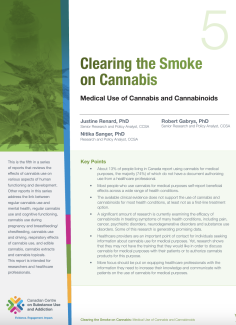Clearing the Smoke on Cannabis and Cannabinoids: Medical Use of Cannabis and Cannabinoids

The report, "Clearing the Smoke on Cannabis: Medical Use of Cannabis and Cannabinoids 2024 Update," examines the medical use of cannabis and cannabinoids, emphasizing their effects, efficacy, and the need for more rigorous research. Key points include:
-
Usage in Canada: Approximately 13% of Canadians use cannabis for medical purposes, with most users self-reporting benefits across various conditions despite lacking formal authorization from healthcare professionals.
-
Clinical Evidence: There is limited clinical evidence supporting cannabis and cannabinoids as first-line treatments for most health conditions. However, ongoing research is exploring their potential in treating pain, cancer, psychiatric, neurodegenerative, and substance use disorders.
-
Healthcare Providers: Many healthcare providers lack adequate training to discuss or authorize medical cannabis use effectively. The report stresses the need to equip these professionals with better knowledge and resources.
-
Efficacy for Specific Conditions:
- Pain: Cannabis is commonly used for pain relief, with mixed results in clinical studies. Some users report significant benefits, but evidence varies by pain type and study.
- Cancer Symptoms: Cannabis may help with cancer pain and chemotherapy-induced nausea and vomiting, though adverse effects are common.
- Neurological Disorders: Limited evidence suggests cannabinoids may alleviate symptoms in conditions like multiple sclerosis and epilepsy.
-
Regulation and Research: The report calls for more high-quality research to confirm the safety and efficacy of medical cannabis. Current cannabinoid medications approved in Canada include nabiximols (Sativex), nabilone (Cesamet), and cannabidiol (Epidiolex) for specific conditions.
The document highlights the complexity of cannabis as a medical treatment and the need for more robust clinical trials to guide its use in healthcare settings.
